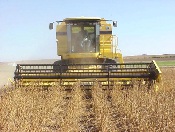ARS: Ozone levels already affecting soybean yields

Current atmospheric ozone levels are already suppressing soybean yields, according to Agricultural Research Service (ARS) scientists and university co-operators studying the effect of global climate change on crops.
ARS plant physiologists Don Ort and Carl Bernacchi, molecular biologist Lisa Ainsworth and geneticist Randall Nelson have been working with University of Illinois scientists on a project called “SoyFACE”–short for Soybean Free Air Concentration Enrichment–to measure how the projected increases in carbon dioxide (CO2) and ozone will affect soybean production. This research supports the U.S. Department of Agriculture priority of responding to climate change.
In their studies, the scientists found that soybean yields increase by about 12 percent at the elevated CO2 levels predicted for the year 2050 (550 parts per million)–only half of what previous studies estimated. They also found that increased ozone is quite harmful to soybean yields, reducing them by about 20 percent. In addition, current levels of ozone are already suppressing soybean yields by up to 15 percent, according to Ort, who is also research leader of the ARS Photosynthesis Research Unit in Urbana, Ill.
These results led the scientists to examine the combined effects of CO2 and ozone changes on soybeans. They found that elevated CO2 partially offsets the ozone damage, confirming general results obtained with open-top chamber studies conducted at other ARS laboratories.
The ability of SoyFACE technology to test effects of CO2 and ozone in the open air, without the environmental modifications caused by the chambers themselves, means greater confidence in understanding how plants respond in the real world, including the actual estimates of impact on crop yields, according to Ort. FACE technology was first used for crop research by ARS scientists in Maricopa, Ariz., and cooperators.
There is much more to be learned about how other interacting factors that affect ozone uptake may come into play by mid-century. Results from these studies will help breeders develop soybean varieties better adapted to the changing climate.
Read more about this research in the November/December 2009 issue of Agricultural Research magazine.











